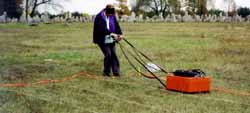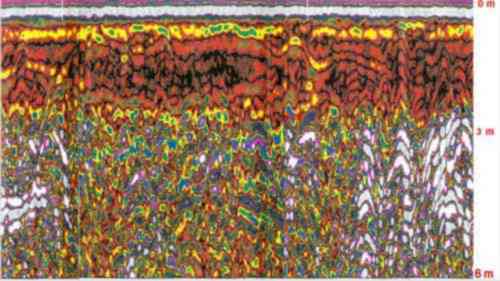Treblinka Ground Radar Examination Finds No Trace of Mass Graves
From The Journal of Historical Review, May/June 2000 (Vol. 19, No. 3), page 20.
A detailed forensic examination of the site of the wartime Treblinka camp, using sophisticated electronic ground radar, has found no evidence of mass graves there.For six days in October 1999, an Australian team headed by Richard Krege, a qualified electronics engineer, carried out an examination of the soil at the site of the former Treblinka II camp in Poland, where, Holocaust historians say, more than half a million Jews were put to death in gas chambers and then buried in mass graves.
According to the Encyclopedia of the Holocaust (1997), for example, "a total of 870,000 people" were killed and buried at Treblinka between July 1942 and April 1943. Then, between April and July 1943, the hundreds of thousands of corpses were allegedly dug up and burned in batches of 2,000 or 2,500 on large grids made of railway ties.
Krege's team used an $80,000 Ground Penetration Radar (GPR) device, which sends out vertical radar signals that are visible on a computer monitor. GPR detects any large-scale disturbances in the soil structure to a normal effective depth of four or five meters, and sometimes up to ten meters. (GPR devices are routinely used around the world by geologists, archeologists, and police.) In its Treblinka investigation, Krege's team also carried out visual soil inspections, and used an auger to take numerous soil core samples.
The team carefully examined the entire Treblinka II site, especially the alleged "mass graves" portion, and carried out control examinations of the surrounding area. They found no soil disturbance consistent with the burial of hundreds of thousands of bodies, or even evidence that the ground had ever been disturbed. In addition, Krege and his team found no evidence of individual graves, bone remains, human ashes, or wood ashes.
"From these scans we could clearly identify the largely undisturbed horizontal stratigraphic layering, better known as horizons, of the soil under the camp site," says the 30-year old Krege, who lives in Canberra. "We know from scans of grave sites, and other sites with known soil disturbances, such as quarries, when this natural layering is massively disrupted or missing altogether." Because normal geological processes are very slow acting, disruption of the soil structure would have been detectable even after 60 years, Krege noted.
While his initial investigation suggests that there were never any mass graves at the Treblinka camp site, Krege believes that further work is still called for.
"Historians say that the bodies were exhumed and cremated toward the end of the Treblinka camp's use in 1943, but we found no indication that any mass graves ever existed," he says. "Personally, I don't think there was an extermination camp there at all."
Krege is preparing a detailed report on his Treblinka investigation. He says that he would welcome the formation, possibly under United Nations auspices, of an international team of neutral, qualified specialists, to carry out similar investigations at the sites of all the wartime German camps.
Krege and his team are associated with, and funded by, the Adelaide Institute, a south Australia revisionist "think tank." Its director, Dr. Fredrick Töben, was jailed in Germany for seven months in 1999 for disputing Holocaust extermination claims.
Sources
"'Vernichtungslager' Treblinka: archaelogisch betrachtet," by Ing. Richard Krege, in Vierteljarhreshefte für freie Geschichtsforschung, June 2000 [4. Jg., Heft 1], pp. 62-64.
"'No Jewish mass grave' in Poland," The Canberra Times, Jan. 24, 2000, p. 6.
"Poland's Jews 'not buried at Treblinka'," The Examiner [Australia], Jan. 24, 2000. [The latter two newspaper items are reprinted in facsimile in VHO-info, May 2000, p. 30.]
Information provided by Richard Krege; M. Weber and A. Allen, "Treblinka," The Journal of Historical Review, Summer 1992, pp. 133-158.
"German Court Sentences Australian Holocaust Skeptic," The Journal of Historical Review, July-August 1999, pp. 2-5.
Y. Arad, "Treblinka," in I. Gutman, ed., Encyclopedia of the Holocaust [New York: 1997], pp. 1481-1488.
Addendum
Forensic investigation of Treblinka:
‘No Jewish mass grave’ in Poland
ADELAIDE: An Australian Holocaust revisionist claims he has proof a mass grave never existed at Treblinka in Poland.
Data collected during a week at Treblinka. using ground penetrating radar, found no soil disturbance consistent with 870,000 Jews having been buried there.
Richard Krege, 30, of Canberra, said data collected during a week at Treblinka. using ground penetrating radar, found no soil disturbance consistent with 870,000 Jews having been buried there.
‘Historians say that the bodies were exhumed and cremated towards the end of the Treblinka camp’s use in 1943. but we found no indication that any mass graves ever existed," he said.
‘Personally, I don’t think there was a [death]-camp there at all.’
Mr Krege, who will address a public meeting in Adelaide tonight at the start of an eight-day tour, said he had gone to Poland in October last year to "find the truth".
A qualified electronics engineer, he is an associate of the Adelaide Institute run by German-born revisionist Dr Fredrick Toben, whom he is accompanying on the tour.
Mr Krege said he would like to see an international group formed, possibly under the auspices of the United Nations, to use ground penetrating radar at all concentration camps in Europe.
He said he was in the process of having other experts review the data he collected, but was confident that they would also conclude the mass burial did not happen.
The young Australian-born man admitted that he expected to be labelled a racist and anti-Semitic.
What is this interesting pattern? A psychedelic painting? The Lord Chancellor's latest wallpaper? No, it is a Ground Penetrating Radar (GPR) scan of the alleged mass grave site at Treblinka, Poland, conducted to a depth of eighteen feet by an expert in November 1999: it seems the ground has remained undisturbed for millions of years. Clever old Nazis, in panic of defeat, managed to put back every stone exactly in place.
Monday
January 24, 2000, page 17:Poland’s Jews ‘not buried at Treblinka’
ADELAIDE - An Australian Holocaust revisionist claims h has proof a mass gray never existed a Treblinka in Poland.
Richard Krege, 30, of Canberra said that data collected during a week at Treblinka, using ground penetrating radar, found no soil disturbance consistent with 870,000 Jews having been buried there.
"Historians say that the bodies were exhumed and cremated towards the end of the Treblinka camp’s use in 1943, but we found no indication that any mass graves ever existed," Mr Krege said
"Personally, I don’t think there was a [death]-camp there at all."
Mr Krege who will address a public meeting in Adelaide tomorrow night as the start of an eight-day national tour, said he had gone to Poland in October last year to find the truth".
A qualified electronics engineer, he is an associate of the Adelaide Institute run by German-born revisionist Dr Fredrick Toben whom he is accompanying on the tour
Click link to download a short video on the project (MPG-format): Secrets Facts - Treblinka, False Concentration Camp
Australian reasearches travel to Treblinka concentration camp, looking for signs and proof of massgraves. They found nothing.

On Treblinka, see also:
- The 1999 Krege Report on the Treblinka Extermination Camp
By Richard Krege
- Comments on Treblinka Statements by Exterminationist "Forensic Expert" Caroline Sturdy Colls
By Thomas Kues
- The Treblinka Archaeology Hoax (2014)

Debunks a widely spread TV programme on an archaeological "investigation" of Treblinka.
Alternative video link (with French subtitles): here
- Treblinka - Wartime Aerial Photos of Treblinka Cast New Doubt on "Death Camp" Claims
By Mark Weber and Andrew Allen
- Absurd "Evidence" Presented at Nuremberg - The "Steam and Electrocution Death Chambers" at Treblinka
From the Holocaust™ Hoax Archive.
- Abraham Bomba, barber of Treblinka
By Bradley R. Smith
- The "Operation Reinhardt" Camps Treblinka, Sobibór, Bełżec—Black Propaganda, Archeological Research, Expected Material Evidence (PDF)
By Carlo Mattogno. Holocaust Handbooks, Volume 28. Castle Hill Publishers, 2021.
|
Races? Only one Human race United We Stand, Divided We Fall |
 |
No time to waste. Act now! Tomorrow it will be too late |
|




































